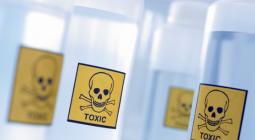Cancer-causing PCB chemicals still being produced despite 40-year-old ban
Exclusive: Research reveals byproduct PCBs may pose ‘growing, unmonitored environmental and human health risk’
Industry could be producing more cancer-causing PCB chemicals today than at any other point in history, despite their production having been banned more than 40 years ago.
PCBs, or polychlorinated biphenyls, are human-made substances that were used as coolants and lubricants in electrical equipment until they were banned due to their links to health problems and because they do not break down easily in the environment.
They are known to cause cancer in animals as well as damage to the immune, reproductive, nervous and endocrine systems. They also have the potential to be carcinogenic in humans and exposure to them has been linked to acne-like skin conditions in adults and neurobehavioural and immunological changes in children.
Research seen by the Guardian and Watershed Investigations shows that PCBs are being produced as byproducts in chemical reactions, which means small proportions of them are present in many chemicals used today.
“This is staggering given that production of PCBs was banned over 40 years ago and we are supposed to be eliminating them under the Stockholm convention,” said the environmental forensic scientist Dr Dave Megson from Manchester Metropolitan University, who conducted the study.
“When we take into account the volumes of these chemicals and the small levels of PCBs within them then this adds up to a massive number – around 45,000 tonnes per year in the US alone.” During peak commercial production in the 1970s about 39,000 tonnes were made each year, states the study.
“Most people associate this accidental production of PCBs with paints and pigments, but our research shows it’s much broader than that,” said Megson. Chlorinated solvents, which are used in chemical manufacturing, are a major source according to the research.
“PCBs are currently going undetected in many studies as the specific PCBs produced accidentally are different from the PCBs that were produced intentionally in the commercial mixtures of 50-plus years ago.”
The study says these kinds of by-product PCBs are not measured in many existing monitoring programmes and may pose a “growing, unmonitored environmental and human health risk”. It suggests they should be classified as “a pollutant of emerging concern” and that they need to be addressed urgently as all PCBs are considered toxic, not just legacy PCBs from commercial mixtures.
Lee Bell from the International Pollution Elimination Network, who is also a member of the Stockholm convention PCB expert group, said: “Not a lot of effort has been made in regulating unintentional production of PCB from chemical manufacture. In the case of intentional PCB production, the parties to the convention have a deadline to eliminate all stockpiles of old PCB by 2028. They are woefully behind on this task and about 80% of PCB stockpiles have yet to be destroyed.
“The study’s assumption that about 43,000 tonnes of PCBs could have been legally produced in 2019 in the US may well be the case despite uncertainties. This would outstrip Monsanto’s 1970 peak US production of 39,000 tonnes in 1970. On a global scale current unintentional PCB production could be much higher and needs urgent investigation.”
Bell says stricter limits should be put in place on releases of legacy and byproduct PCBs to water. “It is disappointing that hundreds of millions of dollars are being spent to destroy legacy PCBs while regulators allow unintentional PCB contamination to spread virtually unabated.”
PCBs have been found at high levels in marine mammals and have long been a concern for Dr Francesca Ginley from the Marine Conservation Society. “PCBs are persistent chemicals … they stick around for decades, building up in the environment and bioaccumulating in marine mammals.
“We have seen the impact of PCBs in the UK killer whale population, which is heading towards a complete collapse within the next hundred years consistent with severe PCB pollution. A killer whale from the west coast of Scotland was found dead in 2016 after being tangled up in fishing nets and a postmortem examination revealed levels of PCBs in her tissues were 100 times higher than the levels known to impact the health of marine mammals,” said Ginley.
Research by the Zoological Society of London with the University of Glasgow last year revealed that UK-stranded orcas are 30 times over the toxic threshold for PCBs. It has warned that the chemicals “threaten to wipe out killer whales”.
PCB production was banned in the US in 1979 and in 1981 in the UK, and work to restrict their use in electrical equipment in the UK is continuing. Sources of legacy pollution from commercially made PCBs include landfills and materials in buildings.
A spokesperson for Defra did not comment on the production of PCBs as byproducts but said: “We have committed to seek to eliminate the use of PCBs by 2025 in our environmental improvement plan, working with industry to register and remove from use all items of equipment that contain these chemicals.
“We have also held a consultation on proposals to amend PCBs regulations to ensure we meet our commitments [under the international Stockholm convention] as well as providing clarity to industry and businesses. Our consultation response and next steps will be published in due course.”
The US Environmental Protection Agency (EPA) said that its “regulations allow inadvertently generated PCBs at low, defined concentrations, and under certain conditions. While there is not a monitoring program, facilities generating or importing inadvertently generated PCBs are required to report this activity to EPA and maintain records about the PCBs, including the levels of PCBs they produced and released.”
The US EPA said it could not comment on Megson’s finding but did say that when the regulations came into force, their information was that “fewer than 11,000lb (4,989kg) of inadvertently generated PCBs were estimated to enter products annually, and of that amount, fewer than 1,000lb annually were likely to enter the environment”.
Last month the EPA received a petition from the Washington State department of ecology on the issue of inadvertently generated PCBs. It requests that EPA “initiate rule making to safeguard public health against PCBs in consumer products”. The EPA must either grant or deny the petition by 3 April 2024.
Ginley said: “If PCBs are still being released, then the problem will just continue to get worse. They aren’t causing short-lived problems; they are impacting entire generations of animals. It’s not just killer whales either, PCBs have been linked to higher mortality from infectious diseases and reduced testes weights in UK harbour porpoises. We should be learning from the ongoing harm caused by PCBs and apply it to other persistent chemicals, not continuing to make the same mistakes.”
Cover photo: An orca off the coast of Shetland. PCBs have been found at very high levels in marine mammals. Photograph: Hugh Harrop/Alamy




